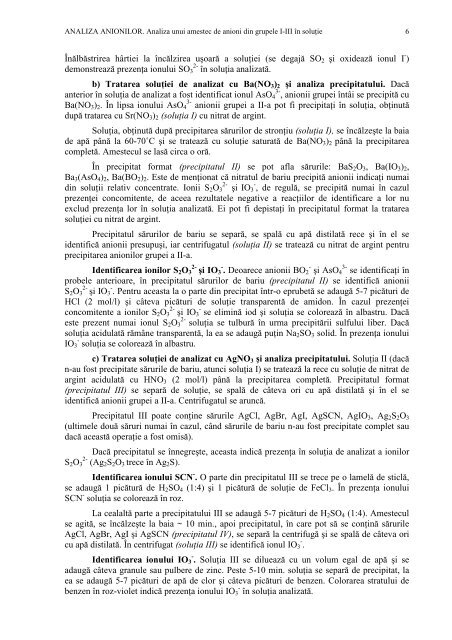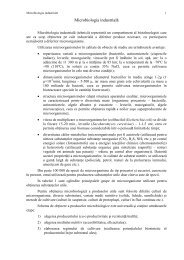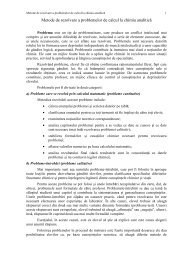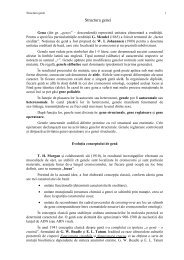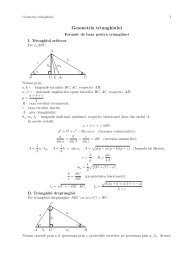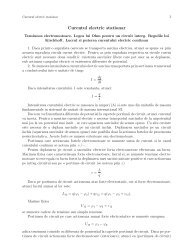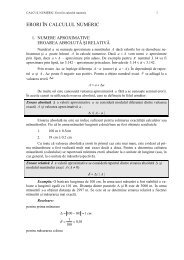Analiza unui amestec de anioni din grupele I-III în soluŃie
Analiza unui amestec de anioni din grupele I-III în soluŃie
Analiza unui amestec de anioni din grupele I-III în soluŃie
You also want an ePaper? Increase the reach of your titles
YUMPU automatically turns print PDFs into web optimized ePapers that Google loves.
ANALIZA ANIONILOR. <strong>Analiza</strong> <strong>unui</strong> <strong>amestec</strong> <strong>de</strong> <strong>anioni</strong> <strong>din</strong> <strong>grupele</strong> I-<strong>III</strong> <strong>în</strong> <strong>soluŃie</strong><br />
Înălbăstrirea hârtiei la <strong>în</strong>călzirea uşoară a <strong>soluŃie</strong>i (se <strong>de</strong>gajă SO2 şi oxi<strong>de</strong>ază ionul I - )<br />
<strong>de</strong>monstrează prezenŃa ionului SO3 2- <strong>în</strong> soluŃia analizată.<br />
b) Tratarea <strong>soluŃie</strong>i <strong>de</strong> analizat cu Ba(NO3)2 şi analiza precipitatului. Dacă<br />
anterior <strong>în</strong> soluŃia <strong>de</strong> analizat a fost i<strong>de</strong>ntificat ionul AsO4 3- , <strong>anioni</strong>i grupei <strong>în</strong>tâi se precipită cu<br />
Ba(NO3)2. În lipsa ionului AsO4 3- <strong>anioni</strong>i grupei a II-a pot fi precipitaŃi <strong>în</strong> soluŃia, obŃinută<br />
după tratarea cu Sr(NO3)2 (soluŃia I) cu nitrat <strong>de</strong> argint.<br />
SoluŃia, obŃinută după precipitarea sărurilor <strong>de</strong> stronŃiu (soluŃia I), se <strong>în</strong>călzeşte la baia<br />
<strong>de</strong> apă până la 60-70˚C şi se tratează cu <strong>soluŃie</strong> saturată <strong>de</strong> Ba(NO3)2 până la precipitarea<br />
completă. Amestecul se lasă circa o oră.<br />
În precipitat format (precipitatul II) se pot afla sărurile: BaS2O3, Ba(IO3)2,<br />
Ba3(AsO4)2, Ba(BO2)2. Este <strong>de</strong> menŃionat că nitratul <strong>de</strong> bariu precipită <strong>anioni</strong>i indicaŃi numai<br />
<strong>din</strong> soluŃii relativ concentrate. Ionii S2O3 2- şi IO3 - , <strong>de</strong> regulă, se precipită numai <strong>în</strong> cazul<br />
prezenŃei concomitente, <strong>de</strong> aceea rezultatele negative a reacŃiilor <strong>de</strong> i<strong>de</strong>ntificare a lor nu<br />
exclud prezenŃa lor <strong>în</strong> soluŃia analizată. Ei pot fi <strong>de</strong>pistaŃi <strong>în</strong> precipitatul format la tratarea<br />
<strong>soluŃie</strong>i cu nitrat <strong>de</strong> argint.<br />
Precipitatul sărurilor <strong>de</strong> bariu se separă, se spală cu apă distilată rece şi <strong>în</strong> el se<br />
i<strong>de</strong>ntifică <strong>anioni</strong>i presupuşi, iar centrifugatul (soluŃia II) se tratează cu nitrat <strong>de</strong> argint pentru<br />
precipitarea <strong>anioni</strong>lor grupei a II-a.<br />
I<strong>de</strong>ntificarea ionilor S2O3 2- şi IO3 - . Deoarece <strong>anioni</strong>i BO2 - şi AsO4 3- se i<strong>de</strong>ntificaŃi <strong>în</strong><br />
probele anterioare, <strong>în</strong> precipitatul sărurilor <strong>de</strong> bariu (precipitatul II) se i<strong>de</strong>ntifică <strong>anioni</strong>i<br />
S2O3 2- şi IO3 - . Pentru aceasta la o parte <strong>din</strong> precipitat <strong>în</strong>tr-o eprubetă se adaugă 5-7 picături <strong>de</strong><br />
HCl (2 mol/l) şi câteva picături <strong>de</strong> <strong>soluŃie</strong> transparentă <strong>de</strong> amidon. În cazul prezenŃei<br />
concomitente a ionilor S2O3 2- şi IO3 - se elimină iod şi soluŃia se colorează <strong>în</strong> albastru. Dacă<br />
este prezent numai ionul S2O3 2- soluŃia se tulbură <strong>în</strong> urma precipitării sulfului liber. Dacă<br />
soluŃia acidulată rămâne transparentă, la ea se adaugă puŃin Na2SO3 solid. În prezenŃa ionului<br />
IO3 - soluŃia se colorează <strong>în</strong> albastru.<br />
c) Tratarea <strong>soluŃie</strong>i <strong>de</strong> analizat cu AgNO3 şi analiza precipitatului. SoluŃia II (dacă<br />
n-au fost precipitate sărurile <strong>de</strong> bariu, atunci soluŃia I) se tratează la rece cu <strong>soluŃie</strong> <strong>de</strong> nitrat <strong>de</strong><br />
argint acidulată cu HNO3 (2 mol/l) până la precipitarea completă. Precipitatul format<br />
(precipitatul <strong>III</strong>) se separă <strong>de</strong> <strong>soluŃie</strong>, se spală <strong>de</strong> câteva ori cu apă distilată şi <strong>în</strong> el se<br />
i<strong>de</strong>ntifică <strong>anioni</strong>i grupei a II-a. Centrifugatul se aruncă.<br />
Precipitatul <strong>III</strong> poate conŃine sărurile AgCl, AgBr, AgI, AgSCN, AgIO3, Ag2S2O3<br />
(ultimele două săruri numai <strong>în</strong> cazul, când sărurile <strong>de</strong> bariu n-au fost precipitate complet sau<br />
dacă această operaŃie a fost omisă).<br />
Dacă precipitatul se <strong>în</strong>negreşte, aceasta indică prezenŃa <strong>în</strong> soluŃia <strong>de</strong> analizat a ionilor<br />
S2O3 2- (Ag2S2O3 trece <strong>în</strong> Ag2S).<br />
I<strong>de</strong>ntificarea ionului SCN - . O parte <strong>din</strong> precipitatul <strong>III</strong> se trece pe o lamelă <strong>de</strong> sticlă,<br />
se adaugă 1 picătură <strong>de</strong> H2SO4 (1:4) şi 1 picătură <strong>de</strong> <strong>soluŃie</strong> <strong>de</strong> FeCl3. În prezenŃa ionului<br />
SCN - soluŃia se colorează <strong>în</strong> roz.<br />
La cealaltă parte a precipitatului <strong>III</strong> se adaugă 5-7 picături <strong>de</strong> H2SO4 (1:4). Amestecul<br />
se agită, se <strong>în</strong>călzeşte la baia ~ 10 min., apoi precipitatul, <strong>în</strong> care pot să se conŃină sărurile<br />
AgCl, AgBr, AgI şi AgSCN (precipitatul IV), se separă la centrifugă şi se spală <strong>de</strong> câteva ori<br />
cu apă distilată. În centrifugat (soluŃia <strong>III</strong>) se i<strong>de</strong>ntifică ionul IO3 - .<br />
I<strong>de</strong>ntificarea ionului IO3 - . SoluŃia <strong>III</strong> se diluează cu un volum egal <strong>de</strong> apă şi se<br />
adaugă câteva granule sau pulbere <strong>de</strong> zinc. Peste 5-10 min. soluŃia se separă <strong>de</strong> precipitat, la<br />
ea se adaugă 5-7 picături <strong>de</strong> apă <strong>de</strong> clor şi câteva picături <strong>de</strong> benzen. Colorarea stratului <strong>de</strong><br />
benzen <strong>în</strong> roz-violet indică prezenŃa ionului IO3 - <strong>în</strong> soluŃia analizată.<br />
6


